Standard [CURRENT]
ASTM D 2241:2025
Standard Specification for Poly(Vinyl Chloride) (PVC) Pressure-Rated Pipe (SDR Series)
- German title
- Anforderungen für Rohre aus Polyvinylchlorid (PVC) nach Druckstufen
- Publication date
- 2025
- Original language
- English
- Pages
- 9
- Publication date
- 2025
- Original language
- English
- Pages
- 9
- DOI
- https://dx.doi.org/10.1520/D2241-25
Product information on this site:
Quick delivery via download or delivery service
Buy securely with a credit card or pay upon receipt of invoice
All transactions are encrypted
Short description
1.1 This specification covers poly(vinyl chloride) (PVC) pipe made in standard thermoplastic pipe dimension ratios and pressure rated for water (see appendix). Included are criteria for classifying PVC plastic pipe materials and PVC plastic pipe, a system of nomenclature for PVC plastic pipe, and requirements and test methods for materials, workmanship, dimensions, sustained pressure, burst pressure, flattening, and extrusion quality. Methods of marking are also given. 1.2 The products covered by this specification are intended for use with the distribution of pressurized liquids only, which are chemically compatible with the piping materials. Due to inherent hazards associated with testing components and systems with compressed air or other compressed gases, some manufacturers do not allow pneumatic testing of their products. Consult with specific product/component manufacturers for their specific testing procedures prior to pneumatic testing. Note 1: Pressurized (compressed) air or other compressed gases contain large amounts of stored energy which present serious safety hazards should a system fail for any reason. Note 2: This standard specifies dimensional, performance and test requirements for plumbing and fluid handling applications, but does not address venting of combustion gases. 1.3 The text of this specification references notes, footnotes, and appendixes which provide explanatory material. These notes and footnotes (excluding those in tables and figures) shall not be considered as requirements of the specification. 1.4 The values stated in inch-pound units are to be regarded as standard. The values given in parentheses are mathematical conversions to SI units that are provided for information only and are not considered standard. 1.5 The following safety hazards caveat pertains only to the test methods portion, Section 8 , of this specification: This standard does not purport to address all of the safety concerns, if any, associated with its use. It is the responsibility of the user of this standard to establish appropriate safety, health, and environmental practices and determine the applicability of regulatory limitations prior to use. A specific precautionary statement is given in Note 9 . Note 3: CPVC plastic pipe (SDR-PR), which was formerly included in this specification, is now covered by Specification F442/F442M . Note 4: The sustained and burst pressure test requirements, and the pressure ratings in the appendix, are calculated from stress values obtained from tests made on pipe 4 in. (100 mm) and smaller. However, tests conducted on pipe as large as 24 in. (600 mm) in diameter have shown these stress values to be valid for larger diameter PVC pipe. Note 5: PVC pipe made to this specification is often belled for use as line pipe. For details of the solvent cement bell, see Specification D2672 and for details of belled elastomeric joints, see Specifications D3139 and D3212 . 1.6 This international standard was developed in accordance with internationally recognized principles on standardization established in the Decision on Principles for the Development of International Standards, Guides and Recommendations issued by the World Trade Organization Technical Barriers to Trade (TBT) Committee.
ICS
23.040.20
DOI
https://dx.doi.org/10.1520/D2241-25
Also available in
Loading recommended items...
Loading recommended items...
Loading recommended items...

